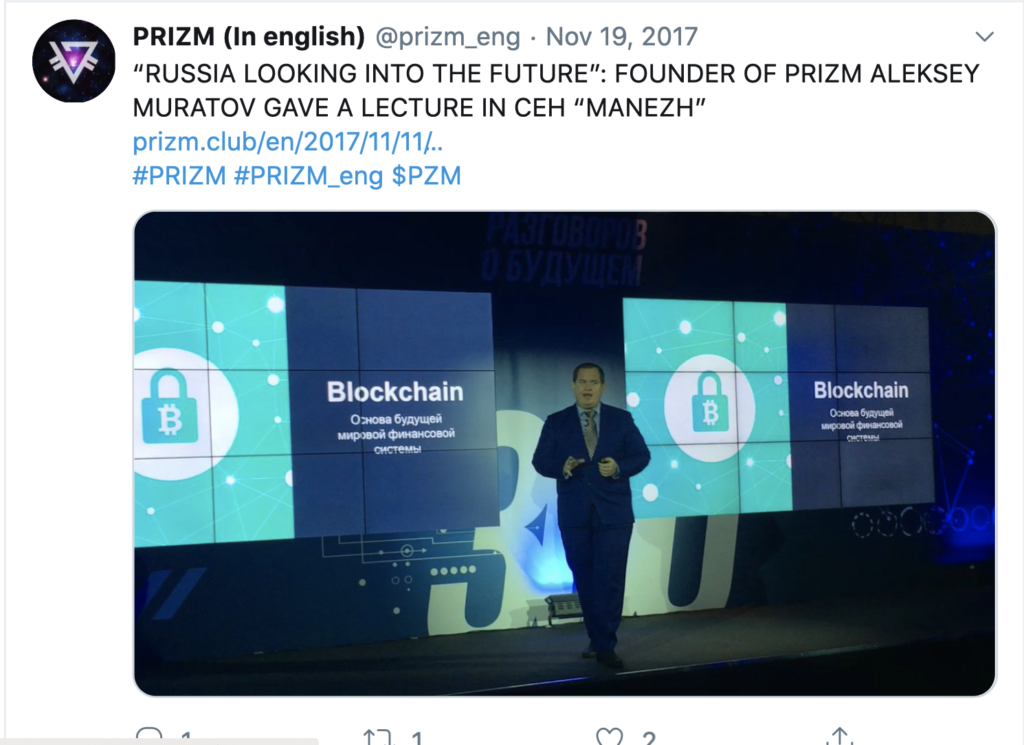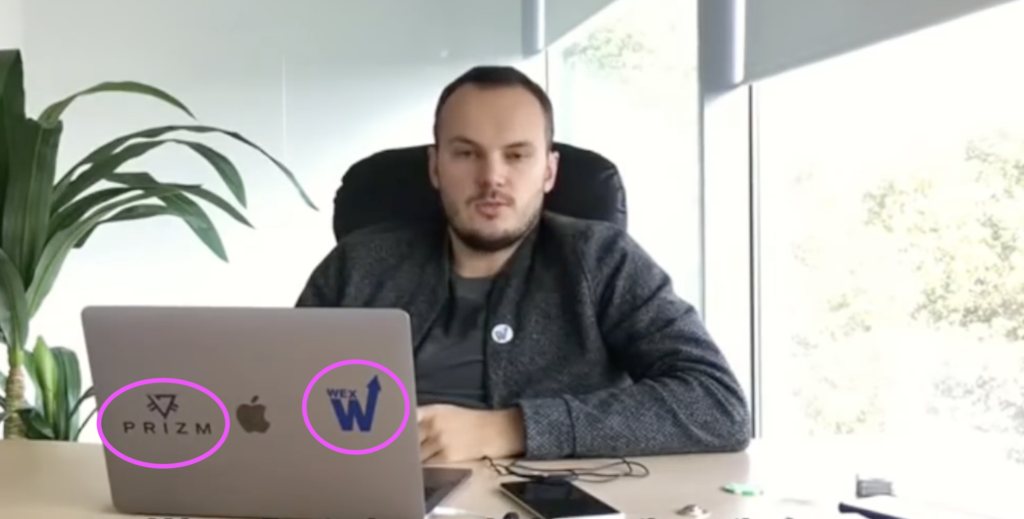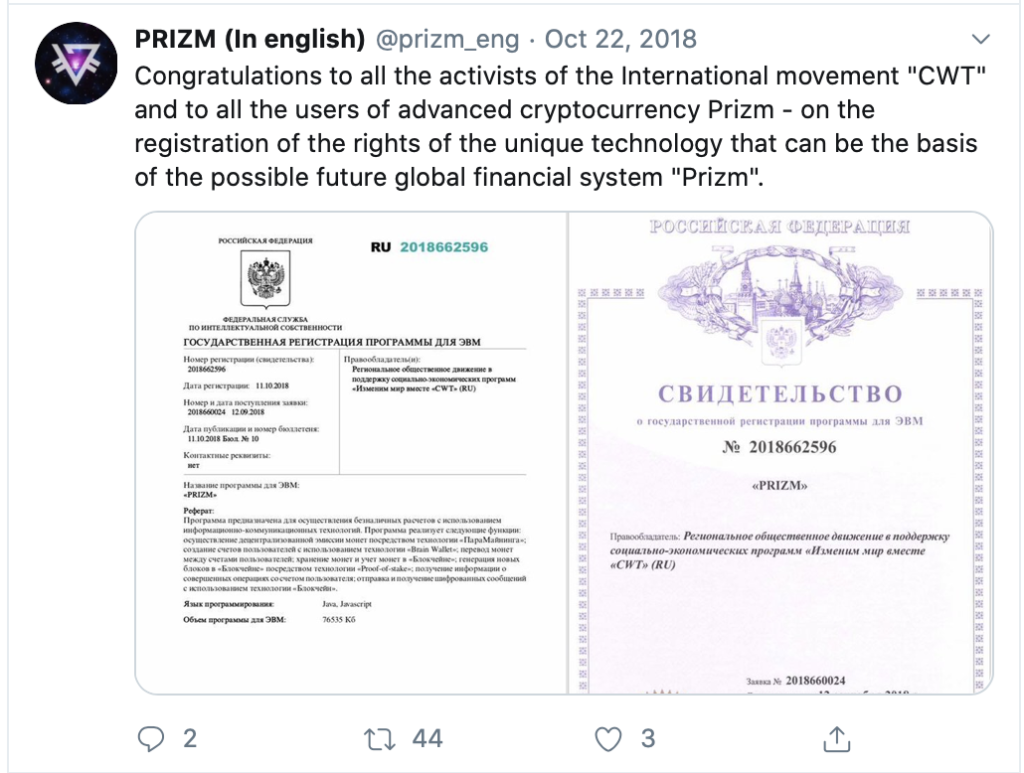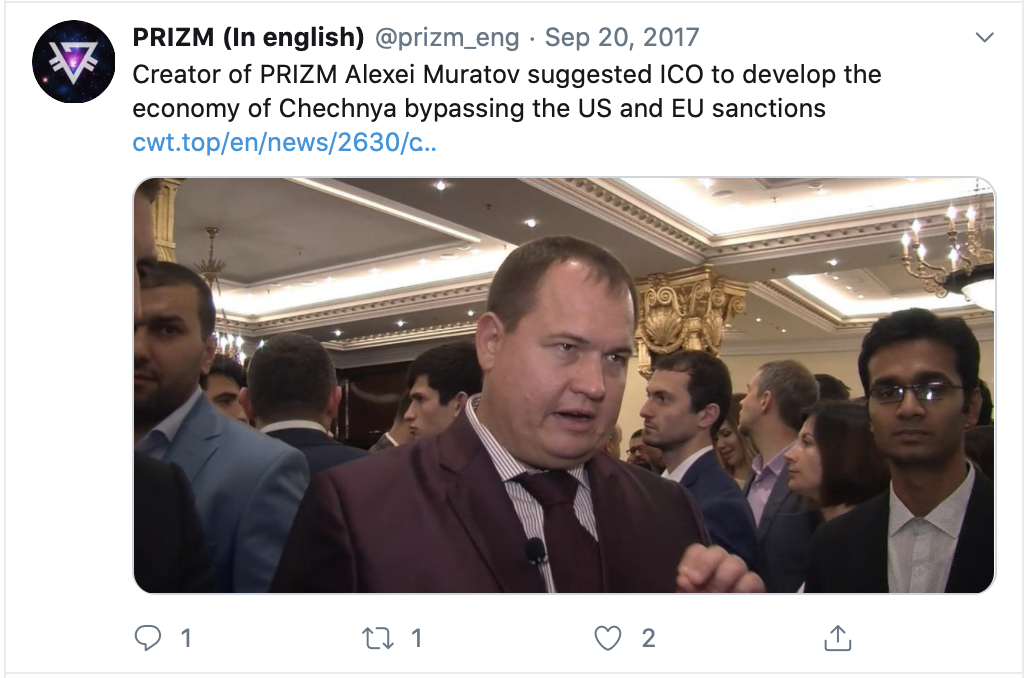Russian on OFAC list launches a coin
The Kharon Brief has an interesting article here about a Ukrainian named Aleksei Muratov, also spelled Aleksey Muratov, on the US sanctions list here, who founded, launched and owns an initial coin offering called PRIZM.

PRIZM whitepaper
The PRIZM coin in the Ukraine has a white paper for investors. It explains that the purpose of its digital currency is to move money anywhere in the world. It promises returns of up to 9.9% for mining via “proof of steak” (presumably “proof of stake”). The coin is popular and does have a Blockchain explorer, which shows peers validating transactions. Its Instagram account promises that by using PRIZM, a user can avoid financial crime laws altogether – it says no identity is collected from a person or required to be given, and it is completely anonymous. It goes so far as to say its transactions are also anonymous and a user can move money anywhere on the planet in seconds.

transfers anywhere on the planet (Source: Instagram)
PRIZM’s promoter is the founder of the defunct WEX exchange, which has US$450 million allegedly missing
PRIZM is being promoted by Dmitriy Vasilyev, the person who co-founded the World Exchange Services (WEX) digital currency exchange allegedly in Singapore. The WEX rose from the ashes of the BTC-e digital currency exchange, shut down by the FBI in conjunction with the Canadian darknet service AlphaBay, founded by Quebecker Alexandre Cazes.
WEX launched an ICO, the WEX ICO, possibly to acquire users from the former BTC-e. More recently, Vasilyev was arrested in Italy in connection with WEX but allegedly subsequently released.

The other co-founder of WEX, Alexei Bilyuchenko (who was an admin of BTC-e), alleges that WEX lost US$450 million because he was forced him to hand over the Trezors holding all of the pooled digital currencies of the exchange and of its customers, as well as all the passwords to a government. Most of what he alleges is untrue.
PRIZM tied to anti-vaxxers
The Ukrainian PRIZM coin is promoted as an “activist” coin on its social media accounts, affiliated with an organization called Change The World (CTW). It is an anti-vaxx organization, calling for an end to all vaccinations globally.

PRIZM founder says ICOs can bypass sanctions
That PRIZM may have been created in Ukraine in part to help Ukrainians to avoid US sanctions seems clear from comments Muratov made. For example, on Twitter below, he suggests that digital currencies can be used to bypass US sanctions. He also runs PRIZM mining farms, creating his own PRIZM coins that he can convert to Bitcoin or cash out on any exchange.

In another possible sanctions avoidance statement, Ukrainians from CTW with Muratov (in the grey hooded jacket), held a ceremony for PRIZM which involved the burning of US dollar bills; whether fake or real is unknown.
And a few months ago, a Ukrainian orthodox priest was called upon to bless PRIZM.
Both Ukrainian groups (PRIZM coin and CTW) held a black tie ball for their activists, and used pictures of Hollywood movie stars and a famous model in a video to suggest they attended the ball (and support PRIZM). None of the movie stars or models in the video attended the event.

Ties to Ponzi scheme called MMM
News agencies that have published interviews of Muratov allege he is a nuclear engineer and was the head engineer of a nuclear power plant for ten years, a post he allegedly left to go into politics at 24-years-old, which would mean he was the head of the nuclear plant’s engineering at 14-years-old, which means he entered university at about 6-years-old.
He later moved to India where he was associated with a Ponzi scheme called Mavrodi Mondial Moneybox (MMM). He was arrested in India in 2013, in connection with MMM. Allegedly, consular officials in India assisted him to return to Ukraine to avoid prosecution for MMM.
Sergey Mavrodi
MMM was a Ponzi scheme that had three or more iterations. The first iteration was started in the 1990s by Sergey Mavrodi, as an investment fund that promised returns of 3,000% to investors. No one seems to know how many billions of dollars were lost but it was apparently equal back then to 1/5 of the Russian central bank’s reserves.
Mavrodi admitted MMM was a Ponzi scheme but said it was a virtuous one. Here, after he was released from prison, he admitted that Russian investors were illiterate and did not know what they were giving money to him for, and that he put most of the money in beneficial ownership arrangements (in shares of other corporations held in the names of other persons for him) and has no intention of paying the billions taken from investors back.
The Mavro ICO
A later iteration involved Bitcoin payments. It launched after the death of Mavrodi. It had its own digital currency called the Mavro (named after Mavrodi). One Bitcoin was equal to one Mavro.
To acquire Mavro coins, a person had to first help another person by sending them Bitcoin, and once a person sent Bitcoin, he or she would get an equal amount of Mavro sent to a wallet, plus 30%. And if they promoted MMM on social media, they could earn more Mavro.
Many of the Ponzi enablers had accounts on BitcoinTalk where they lured people in and solicited payments in Bitcoin. The Mavro appears to have been capable of being used for nothing and in essence, investors were just sending Bitcoin away to strangers and getting nothing in return except access to a wallet that held a certain balance of useless Mavro coins.
It was the model that would be used by OneCoin a few years later.
At its peak, the iteration of this MMM scheme circulated more than US$150 million dollars a day. The scheme was a a zero-sum investment model, in which one person’s loss was another’s gain. The scheme took money from victims in over 80 different countries, mostly from India and Indonesia. Transactional analysis showed that much of the funds stayed in Indonesia, suggesting the funds are parked there. Academics have found that a large portion of the proceeds of crime from this particular iteration of the MMM scheme went through digital currency exchanges.
Muratov does not downplay a role in MMM or his admiration for Mavrodi. They are both promoted on the CTW blog here, which alleges that MMM and Mavrodi were responsible for the growth of digital currencies in the world and the blog promises to continue the work of Mavrodi with MMM.
MMM is starting a new iteration with a new website for the coin, with a promotional video explaining how the Mavro coin was founded by Mavrodi after his incarceration, and extolling the virtues of MMM. It’s basically a commercial about how Mavrodi was a hero for taking a US$1 billion from Russians under the MMM banner and how the Russian government allegedly stole all the money (implying that Mavrodi couldn’t pay anyone back). Recently, the MMM was renamed MMM BSC on the same YouTube channel.
You can buy Prizm in Canada
Most surprising of all, you can buy the PRIZM ICO in Canada.
Despite the heightened financial crime risks, its creator being on a US sanctions list, the ties to the MMM scheme, the ties to BTC-e, AlphaBay and WEX, Coinsquare, a digital currency exchange in Canada, teaches one how to buy and sell PRIZM, and to move the proceeds back out to your bank using their Canadian bank.